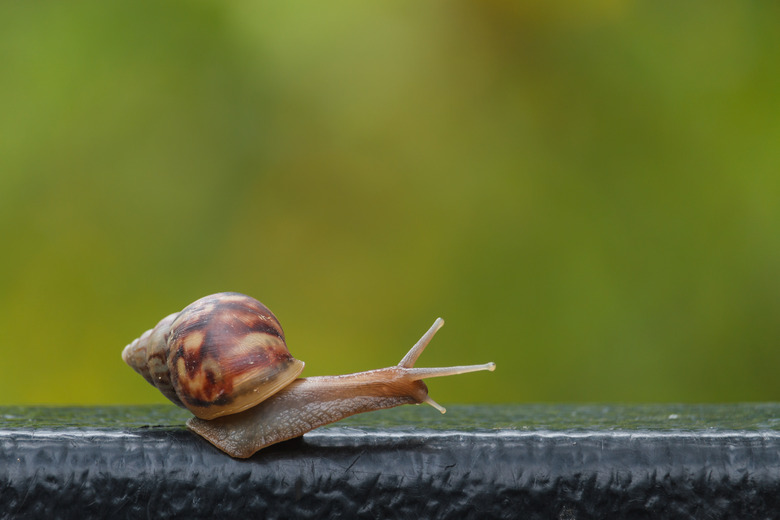Characteristics Of Snails & Slugs
Slugs and snails are close relatives, both belonging to the class Gastropoda, along with sea slugs, nudibranchs, conchs, whelks and limpets. Gastropod literally means "stomach foot" and is a direct reference to how the stomach of a snail or slug lies above its large fleshy foot. A terrestrial snail or slug secretes mucus from a gland in its muscular foot, which helps it move and leaves behind a distinctive slime trail.
General Body Structure
General Body Structure
A snail's body consists of five main parts – the head, the neck, the visceral hump, the tail and the foot. A slug has the same essential parts, except for the visceral hump or shell. The mantle, which covers the forward fourth or third of the slug's back, serves as protection for its internal organs, though it still has a remnant of a shell at its tail end. Snails and slugs have two pairs of tentacles – one pair bearing the eyes and the other serving as smelling organs.
Reproduction
Reproduction
Both slugs and snails are hermaphrodites, meaning that both male and female organs are present in a single body. Apple and periwinkle snails are two notable exceptions, with distinct male and female members of the species. Snails and slugs have reproductive organs close to the top of their bodies to facilitate mating. Fertilization is simultaneous, with two individual snails or slugs exchanging bundles of sperm. Most species lay their eggs underground, though a few are ovoviviparous, giving birth to live young.
Feeding Habits
Feeding Habits
Snails and slugs use a rough tongue called a radula – an organ much like a horny file – for rasping away at their food and scraping it into their mouths. Their teeth, which are made of chitin, also aid in breaking down their food. Their diet includes algae, fungi, dead organic matter and a variety of field and garden crops. Ripe strawberries and tomatoes are among their favorite treats. A few species are carnivorous – such as the Red Daudebardia snail and the Sicilian predator snail – and feed on earthworms, insect larvae and other snails. These species have long sickle-shaped radulae.
Habitat
Habitat
Snails and slugs can live in nearly every habitat on the planet, including salt and freshwater. They favor moist environments such as moss, tree bark, piles of damp refuse and rotting logs. Slugs, which aren't protected by a shell, are vulnerable to desiccation during particularly dry seasons. Some snails protect their soft tissues by closing their operculum, or shell door, as they retreat. Still other snails survive dry periods by resorting to aestivation, a form of hibernation, in which they seal themselves in their shells with a layer of dried mucus and remain dormant until conditions become favorable. Some species can stay inactive for as long as 4 years.
Cite This Article
MLA
Johnson, Steve. "Characteristics Of Snails & Slugs" sciencing.com, https://www.sciencing.com/characteristics-snails-slugs-8356289/. 19 April 2018.
APA
Johnson, Steve. (2018, April 19). Characteristics Of Snails & Slugs. sciencing.com. Retrieved from https://www.sciencing.com/characteristics-snails-slugs-8356289/
Chicago
Johnson, Steve. Characteristics Of Snails & Slugs last modified March 24, 2022. https://www.sciencing.com/characteristics-snails-slugs-8356289/
